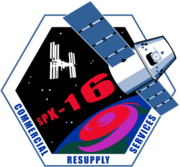 CRS-16 Dragon approaching the ISS | |
| Names | SpX-16 |
|---|---|
| Mission type | ISS resupply |
| Operator | SpaceX |
| COSPAR ID | 2018-101A |
| SATCAT no. | 43827 |
| Mission duration | 39 days, 10 hours, 54 minutes |
| Spacecraft properties | |
| Spacecraft | Dragon 1 C112 |
| Spacecraft type | Dragon 1 |
| Manufacturer | SpaceX |
| Dry mass | 4,200 kg (9,300 lb) |
| Dimensions | Height: 6.1 m (20 ft) Diameter: 3.7 m (12 ft) |
| Start of mission | |
| Launch date | 5 December 2018, 18:16:00 UTC |
| Rocket | Falcon 9 Block 5 (B1050) |
| Launch site | Cape Canaveral, SLC-40 |
| End of mission | |
| Disposal | Recovered |
| Landing date | 14 January 2019, 05:10 UTC [1] |
| Landing site | Pacific Ocean off Baja California |
| Orbital parameters | |
| Reference system | Geocentric orbit |
| Regime | Low Earth orbit |
| Inclination | 51.6° |
| Berthing at ISS | |
| Berthing port | Harmony nadir |
| RMS capture | 8 December 2018, 12:21 UTC[2][3] |
| Berthing date | 8 December 2018, 15:36 UTC [4] |
| Unberthing date | 13 January 2019, 20:00 UTC [5] |
| RMS release | 13 January 2019, 23:33 UTC [6] |
| Time berthed | 36 days, 4 hours, 24 minutes |
| Cargo | |
| Mass | 2,573 kg (5,672 lb) |
| Pressurised | 1,598 kg (3,523 lb) |
| Unpressurised | 975 kg (2,150 lb) |
 NASA SpX-16 mission patch | |
SpaceX CRS-16, also known as SpX-16, was a Commercial Resupply Service mission to the International Space Station launched on 5 December 2018 [7] aboard a Falcon 9 launch vehicle.[8] The mission was contracted by NASA and is flown by SpaceX.
This CRS mission was the first to be launched by the Falcon 9 Block 5. It carried the Global Ecosystem Dynamics Investigation (GEDI) lidar and the Robotic Refueling Mission 3 (RRM3) experiment as external payloads.
- ^ Bergin, Chris (14 January 2019). "CRS-16 Dragon returns to Earth following ISS departure". Spaceflight Now. Retrieved 21 January 2019.
- ^ "Dragon in the Grips of Robotic Arm, Installation Occurs Next". NASA. 8 December 2018. Retrieved 8 December 2018.
 This article incorporates text from this source, which is in the public domain.
This article incorporates text from this source, which is in the public domain.
- ^ Gebhardt, Chris (8 December 2018). "Dragon brings the science; NASA, SpaceX realign DM-1 test to NET 17 January launch". NASASpaceFlight.com. Retrieved 8 December 2018.
- ^ Garcia, Mark. "Dragon Attached to Station, Returns to Earth in January". NASA. Archived from the original on 14 December 2018. Retrieved 8 December 2018.
 This article incorporates text from this source, which is in the public domain.
This article incorporates text from this source, which is in the public domain.
- ^ Richardson, Derek (13 January 2019). "CRS-16 unberthing, splashdown". Orbital Velocity. Archived from the original on 19 April 2019. Retrieved 12 August 2020.
- ^ Richardson, Derek (14 January 2019). "SpaceX Completes 16th Dragon Mission to ISS". Spaceflight Insider. Retrieved 12 August 2020.
- ^ Lewin, Sarah (5 December 2018). "SpaceX Launches Dragon Cargo Ship to Space Station, But Misses Rocket Landing". Space.com. Retrieved 15 December 2018.
- ^ Pietrobon, Steven (1 November 2018). "United States Commercial LV Launch Manifest". Retrieved 1 November 2018.